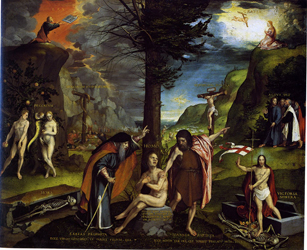


Rowlands, Holbein, p. 93:
"The most significant work that Holbein produced to promote the tenets of the Reformers is The Old and New Law, formerly at Ince Blundell Hall, and now in the National Gallery of Scotland, Edinburgh..... Obvious thematic parallels to this elaboration of the new Reformation interpretation of the relation between the Old and New Testaments are found in the works of Lucas Cranach and his school. From 1529 onwards Cranach's workshop was producing paintings with explanatory texts of the Fall and Redemption of Man, and probably in the next year, Cranach himself designed a woodcut of the same subject and composition, whose message was based on the same attitude to the doctrine of salvation as that put forward in Holbein's painting. They were arranged in a broadly similar composition with a tree, alive on one side, dead on the other, dividing the picture into two equal halves, signifying the old and new Dispensations. In this new theological interpretation of scripture, the Old Testament was seen more as a contrast and antithesis to the New Testament, and less as a prefiguration of the New, as previously occurred. To the Reformers in their polemic the Old Testament was made to stand for the 'Old Religion', an antipathy confined in the Middle Ages to that between the Synagogue and the Church. Luther had been urging on Christendom for many years the vital significance, as he saw it, of the Pauline antithesis between the Law of the Old Testament, which brings only consciousness of sin, and the Redemption through faith in Christ, whose death on the cross is a full expiation for 'the sins of the whole world.' The appearance from Cranach's studio of the first pictorial didactic expositions of this doctrine in the same year as the publication of Luther's 'Little Catechism' can hardly be an accident. The reformer had been considering too, ever since the iconoclasm prompted by Karlstadt at Wittenberg, the provision of a new iconography to match and explain the new theological interpretations he was advocating. Both the paintings and prints by Cranach and his workshop and that by Holbein clearly expound Luther's interpretation of the Pauline text and include doctrinal features of the late medieval painting tradition for the representation of the Old Law, of which Luther strongly disapproved. These were subjects, such as the Last Judgement, in which the 'double intercession' of Christ and the Virgin was a key element --a futher bone of contention between himself and the Catholic theologian, Johann Eck."
For the Edinburgh panel, see Fritz Grossmann, "A Religious Allegory by Hans Holbein the Younger," Burlington Magazine 103(1961): 491-494.
